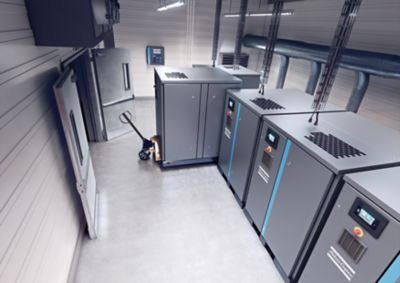Is your compressed air system doing Dry January this year?
Each winter the ‘Dry January’ campaigners’ remit is to limit the country’s social liquid intake, but it is also the time when compressor users could be battling with a real problem that is quite the opposite – keeping any moisture, with the potential to freeze, out of the air supply and its point of use. A compressor user may think that their compressed air system is moisture-free but, when temperatures start to drop below 5˚C, this may no longer be the case.
Older dryers can sometimes fail or lose their gas and then no longer provide the required 3 degrees dewpoint (Class 4 of the ISO 8573.1 quality standard), which is the most common requirement for the UK’s weather conditions. From experience, such a failure may go unnoticed until the cold winter months when moisture drop-out leads to product spoilage.
Making sure it will be a Dry January
To make certain that your compressed air system is at a standard that is ready to cope with the possibility of severe winter conditions, it will pay to call in your supplier’s service engineering assistance and advice at the earliest opportunity.
A site visit to carry out a thorough but unintrusive installation check-up will answer such questions as ‘Do we need a different size or type of dryer to cope with installation changes’, or ‘Should it be a VSD version to reduce our energy costs?’ and, of prime importance, ‘Is there a threat of water in the system?’ a problem that can be readily identified by calling in an engineer with a portable hygrometer moisture checker to the site. Now is the time to take steps to protect your compressor system and make certain it is still delivering air of optimum quality.
Andy Lill, Business Development Manager, Quality Air, Atlas Copco Compressors
The importance of air quality
Atmospheric air drawn into a compressor intake will contain particulate and water vapour. That is why the quality of compressed air is defined by the levels of different contaminants present in the airflow, which, to a large extent, dictate the air treatment needed to remove them. In particular, the presence of water in the air network when ambient temperatures plunge be can be a severe concern but a problem that, with the aid of appropriate water separators, filters, and dryers downstream, can be overcome.
Compressed air dewpoint
The role of the dryer
The refrigerant dryer
F-gas regulations
Compressor users with systems that include standalone or integrated refrigerant dryers need to be aware of the fundamental changes that have taken place with the use, availability and latest regulations concerning refrigerants, the F-gases. As from January 2020, the F-gas Regulations banned the use of refrigerants with a high Global Warming Potential (GWP) above a rating of 2500 in all-new stationary refrigeration equipment. Furthermore, the operation and servicing of equipment, the handling of F-gases and their disposal are all now subject to strict regulations. For example, gases which are no longer supported cannot be replenished. Even if reclaimed gas is available, it could prove to be more costly than purchasing a new dryer. Even some dryers less than five years old could contain refrigerant that is difficult to source, thus making repairs, in the event of re-gassing, problematic to carry out. The most typical dryer failure is when the gas leaks from the system. As far as compressed air refrigerant dryer users are concerned, not only will they have to adopt new disciplines for maintenance, servicing, record keeping and personnel competence issues, they also have to accept that in the event of equipment breakdown or leak it may not be possible to repair the unit or replace the original refrigerant. In terms of service provision, it is now specified that contractors – both operatives and companies – must be certified to carry out tasks or services on certain types of refrigeration equipment, including installation, maintenance, servicing, leak checking, repair, decommissioning and disposal of old systems, and recovery of refrigerant gases. Be sure that your supplier is competent and qualified to do so. In keeping with significant compressor dryer manufacturers, Atlas Copco is ahead of the game with its energy-efficient solutions such as its FX/FD low- maintenance dryer range which employs gases with a low global warming potential (GWP) such as the R10A4A refrigerant - and offers a 2-year warranty into the bargain.
How to ensure a Dry January
Watch our Introduction to Compressed Air Treatment training
Editor’s notes:
● Energy-saving VSD refrigerant dryers: Where class 4 refrigerant dryers are unlikely to be exposed to severe conditions, the latest developments in variable speed drive refrigerant dryers technology has proven to deliver superior results in terms of energy use, dew point stability and service costs. A VSD refrigerant dryer uses an inverter to vary the speed of the refrigeration compressor to match the cooling requirements of the dryer to the water vapour loading of the incoming compressed air.
● F-gas phase-down: In 2015, new F-gas regulations introduced a staged phase-down in the use of F-gas to restrict availability through a gradual reducing quota system for F-gas producers and importers. Already reduced by 30% since 2015, the ultimate objective is to achieve an 80% cut in the availability of HFCs by the year 2030.
Atlas Copco Compressor Technique 2021 News Tag of displayed articles Air compressor products, parts and service Product

